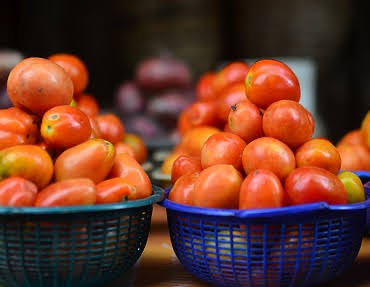Nigerians appear to be recovering from the high tomato prices as the Tomato and Fruit Growers Association of Nigeria, TOPANN, has asserted that the current high prices of tomatoes will come down in July following a bumper harvest in Plateau State, one of the major tomato producing states in Nigeria.
In an interview, the National President of TOPANN, Mr. Oyeleke Bola, made the assertion while speaking on the factors behind the nationwide price hike of tomatoes.
According to Bola, late rains were one of the main causes, which were later exacerbated by Tuta absoluta, also known as tomato Ebola. Farmers in Kano bore the brunt, which has not stopped the price hike.
The best months to plant tomatoes in Nigeria are December to March. Planting tomatoes in December, January, February and March will allow you to harvest in the lean season of May to August. Tomato prices peak between May and August.
He said, “Smallholder farmers and the association faced many challenges in 2024. First of all, the weather was not favorable for us. The rains were late and the first rains caused intense heat in the soil, destroying almost hectares of land that were used for tomato cultivation in Kano State and other parts of the country.
“While we were trying to overcome this challenge, the tomato Ebola, also known as Tuta absoluta, broke out and severely damaged our tomatoes. This was really serious and negatively affected our investment in tomatoes and made it difficult for our farmers to cope.
“However, there is now a tomato harvest in Plateau State and it may be enough to at least lower the price of tomatoes in the market. We want to do our best to prepare the soil for the rainy season. However, rice planting is delayed this year. However, small-scale farmers are suffering huge losses during the dry season, so we are trying to find out what we can do.
“Another challenge is the high cost of transportation, which has a major impact on the current price of tomatoes in the market. However, with the arrival of the new crop in major cities such as Lagos, Abuja, and Port Harcourt, the high price of tomatoes will come down somewhat by mid-July at the latest, he said, adding that tomato farmers are learning from the current experience of adverse weather conditions affecting tomato production and adapting to ensure that they do the necessary before, during and after planting tomatoes.
“At the same time, he said that with large investments from the private sector and government collaborating with the private sector, year-round production of tomatoes will be an important solution to the problem of scarcity and high prices of tomatoes in the market.
“Yes, year-round production of tomatoes is possible if the private sector and government collaborate and also use technology in soil preparation and mechanization for smallholder farmers. That way, we can have three tomato production seasons a year.”
“It will be positive for us because it will lead to increased yields and industrialization. We are talking about GMOs because our yields are low and we want to know how to feed ourselves and other African countries.
“But we have local seeds that can be improved by institutions like the National Institute of Horticultural Research (NIHORT) and they also give very good yields so we can feed the population because the population is growing but with this yield, we can do that. We are not producing enough to feed the population so we need more players in the value chain in terms of processing and technology.”
On their demands, the tomato chief said: “I would like to ask the Minister of Agriculture and Food Security to create a Federal Tomato Development Unit within the ministry. It will basically focus on tomato production in terms of seed development, technology adoption, capacity building of farmers, extension services, construction of processing and storage facilities, and ensuring year-round mass production, among other things, as it is one of the most important horticultural products consumed by Nigerians on a daily basis.
“This will go a long way in addressing the challenges along the tomato value chain and investors can also invest in seeds, fertilizers, irrigation, processing, etc.”


































